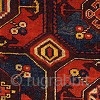Central Asia
Mid 19th Century
370 x 208 cm (12’2” x 6’10”)
Asymmetrically knotted wool pile on wool and hand-spun cotton
Carpets from the non-Turkoman populations of central Asia such as the Uzbeks, the Karakalpaks and the Kirghiz have started to appear more frequently in the West, particularly since the fall of the Soviet empire. As there is very little literature about them, they represent a very interesting core of weavings which, together with their related embroideries, felts and other tribal trappings, are now one of the most actively collected areas among rug connoisseurs.
This early example is characterised by its design of large gulli guls, most of which feature different inner decorations, with repeatedly different secondary guls. An ancient treatment of pattern, typical of Turkish rugs of the Seljuk and early Ottoman period, can be seen in the empty space left in proximity of the border, as if the frame is not interrupting an infinite repeat but only containing it. The very unusual border of connected totemic-like forms adds another archaic touch to the composition.
- Home
- Antique Rugs by Region
- Category
- Profiles
- Post Items Free
- Albums
- Benaki Museum of Islamic Art
- Budapest: Ottoman Carpets
- Gulbenkian Museum
- Islamic Carpets. Brooklyn
- Islamic Textiles. Brooklyn
- Konya Museum: Rugs
- MKG, Hamburg
- MMA: Caucasian Carpets
- MMA: Mamluk Carpets
- MMA: Mughal Indian Carpets
- MMA: Ottoman Carpets
- MMA: Safavid Persian Carpets
- MMA: Turkmen Rugs
- McCoy Jones Kilims
- Ottoman textiles. Met
- Philadelphia Museum
- Rugs and Carpets: Berlin
- Seljuqs at the Met
- TIEM, Istanbul: Carpets
- V&A: Classical Carpets
- Vakiflar Carpets: Istanbul
- Baluch Rugs: Indianapolis
- Gallery Exhibitions
- Jaf an Exhibition
- Alberto Levi Gallery
- Andean Textile
- Christie's London: 2016
- Francesca Galloway
- HALI at 40
- ICOC Washington, DC 2018
- Jajims of the Shahsavan
- London Islamic Week April, 2018
- Mongolian Felts
- Navajo Rugs: JB Moore
- Persian Piled Weavings
- SF Tribal & Textile Art Show 2020
- SF Tribal 2019
- Sotheby's: C. Alexander
- Turkish Prayer Rugs
- Turkmen Main Carpets ICOC 2007








